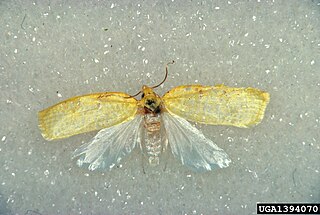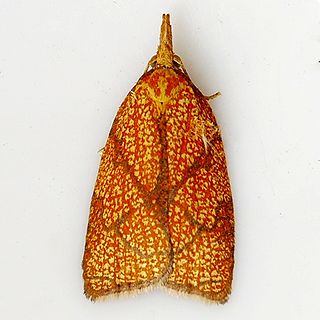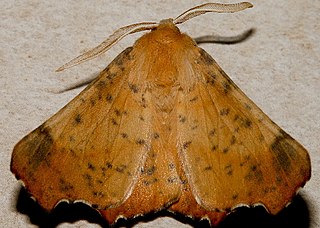
The Tortricidae are a family of moths, commonly known as tortrix moths or leafroller moths, in the order Lepidoptera. This large family has over 11,000 species described, and is the sole member of the superfamily Tortricoidea, although the genus Heliocosma is sometimes placed within this superfamily. Many of these are economically important pests. Olethreutidae is a junior synonym. The typical resting posture is with the wings folded back, producing a rather rounded profile.

Dryocampa rubicunda, the rosy maple moth, is a small North American moth in the family Saturniidae, also known as the great silk moths. It was first described by Johan Christian Fabricius in 1793. The species is known for its wooly body and pink and yellow coloration, which varies from cream or white to bright pink or yellow. Males have bushier antennae than females, which allow them to sense female pheromones for mating.

Chlidanotinae is a subfamily of moths in the family Tortricidae.

Acleris forsskaleana, the maple leaftier moth, is a moth of the family Tortricidae. It is found in Europe and North America in woodlands and gardens.

Acleris sparsana is a moth of the family Tortricidae found in Europe and Iran. It was first described in 1775 by the Austrian lepidopterists Michael Denis and Ignaz Schiffermüller.

Archips xylosteana, the variegated golden tortrix or brown oak tortrix, is a moth of the family Tortricidae.

Aleimma loeflingiana is a moth of the family Tortricidae. It is found in Europe and the Near East.

Acleris is a genus of moths belonging to the subfamily Tortricinae of the family Tortricidae. As of 2007, about 241 species were known.

The maple-basswood leafroller is a moth of the family Tortricidae. It is found in eastern North America, from Nova Scotia to Florida, west to Texas.

The reticulated sparganothis is a moth of the family Tortricidae. It is found in most of eastern North America.

Acleris hastiana is a moth of the family Tortricidae. It is found in Europe, northern Iran, Kazakhstan, Ala Tau, central Siberia, Irkutsk, the Amur region and China. In North America it is found from the north-eastern United States across southern Canada to British Columbia and south along the Pacific Coast to California.

Episimus tyrius, the maple tip borer moth or maple leaftier moth, is a species of moth in the family Tortricidae. It is found in the eastern United States from New York to Florida west to Texas.

Proteoteras willingana, the eastern boxelder twig borer moth, is a moth of the family Tortricidae. It is found in southern Canada and the eastern United States, west through the Great Plains.

Catastega aceriella, the maple trumpet skeletonizer moth, is a moth of the family Tortricidae. It is found in North America from southern Ontario and Nova Scotia to North Carolina and Tennessee.

Ennomos magnaria, the maple spanworm moth, notched wing moth, notched-wing geometer or notch-wing moth, is a moth of the family Geometridae. The species was first described by Achille Guenée in 1858. It is found from coast to coast in southern Canada and the northern United States, south in the east to Florida and Louisiana and in the west to California.
Józef Razowski is a Polish entomologist and lepidopterist specializing in Tortricidae. He is an honorary member of the Polish Entomological Society and a working member of the Polish Academy of Arts and Sciences (PAU). From 1988 to 1997, Razowski headed the Institute of Systematics and Evolution of Animals.

Acleris chalybeana, the lesser maple leafroller moth, is a species of moth of the family Tortricidae. It is found in North America, where it has been recorded from Arkansas, Connecticut, Florida, Illinois, Indiana, Kentucky, Maine, Maryland, Mississippi, New Hampshire, New Jersey, New York, North Carolina, Ohio, Ontario, Pennsylvania, Quebec, South Carolina, Tennessee, West Virginia and Wisconsin.

Proteoteras naracana is a moth of the family Tortricidae. It is found in North America, where it has been recorded from Alabama, Illinois, Indiana, Kentucky, Maryland, Massachusetts, Ohio, Pennsylvania, Tennessee, West Virginia and Wisconsin.

Epinotia abbreviana is a moth of the family Tortricidae. It is found in Europe and was first described by Johan Christian Fabricius in 1794.



















